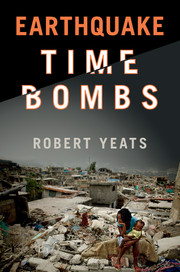Book contents
- Frontmatter
- Contents
- Acknowledgments
- Why this book?
- PART I EARTHQUAKES, DEEP TIME, AND THE POPULATION EXPLOSION
- PART II EARTHQUAKE TIME BOMBS
- TIME BOMBS WHERE THE PROBLEM IS UNDERSTOOD, BUT THE RESPONSE IS STILL INADEQUATE
- 6 San Francisco Bay Area
- 7 Los Angeles
- 8 Seattle, Portland, and Vancouver: Cascadia subduction zone
- 9 Japan: Tokyo and the Kansai
- 10 Wellington, New Zealand
- 11 Santiago, Chile
- 12 Prologue in central China
- OTHER TIME BOMBS, INCLUDING CITIES THAT ARE NOT WELL PREPARED
- PART III SUMMARY AND RECOMMENDATIONS
- References
- Index
12 - Prologue in central China
from TIME BOMBS WHERE THE PROBLEM IS UNDERSTOOD, BUT THE RESPONSE IS STILL INADEQUATE
Published online by Cambridge University Press: 05 November 2015
- Frontmatter
- Contents
- Acknowledgments
- Why this book?
- PART I EARTHQUAKES, DEEP TIME, AND THE POPULATION EXPLOSION
- PART II EARTHQUAKE TIME BOMBS
- TIME BOMBS WHERE THE PROBLEM IS UNDERSTOOD, BUT THE RESPONSE IS STILL INADEQUATE
- 6 San Francisco Bay Area
- 7 Los Angeles
- 8 Seattle, Portland, and Vancouver: Cascadia subduction zone
- 9 Japan: Tokyo and the Kansai
- 10 Wellington, New Zealand
- 11 Santiago, Chile
- 12 Prologue in central China
- OTHER TIME BOMBS, INCLUDING CITIES THAT ARE NOT WELL PREPARED
- PART III SUMMARY AND RECOMMENDATIONS
- References
- Index
Summary
The explosive migration of humanity to major cities in the developing world is by and large a modern phenomenon, a byproduct of the growth of population worldwide in the past century. Most of the time bomb cities featured in this book either did not exist at all hundreds of years ago, like Port-au-Prince or Nairobi, or were relatively small cities at that time, like Kabul. There is one major exception, however; the cities of central China.
As discussed below, China has the largest government organization on Earth for the study of earthquakes, and so its cities are as well prepared as those discussed above. The difference in central China is that a population explosion took place hundreds of years before others discussed below, and so losses were high, with one earthquake causing more deaths than any others in Earth's history. For this reason, this chapter is described as a “prologue.”
China's civilization is thousands of years old, and during most of that time its capital was in the valley of the Wei River (Weihe), itself a tributary of the Yellow River (Huanghe) in modern Shaanxi Province (Figure 12.1). The famous terra cotta warriors of modern Xi'an were an inspiration of Qin Shi Huangdi, the first emperor of China, in the third century BC. During the Han Dynasty, 2000 years ago, the city of Chang'an in the Wei River valley was the Chinese terminus of the Silk Road between Europe and the Far East. For many centuries, Chang'an was a center of Buddhist and Taoist culture, with great temples and pagodas. Even Christians thrived there. Chang'an, renamed Xi'an in the fourteenth century AD, had streets that were laid out on a grid pattern oriented north–south and east–west, with broad avenues, some with median strips. The street plan became a model for other Asian cities, including Nara and Kyoto in Japan, and is followed by many American cities today, such as Salt Lake City, Utah.
- Type
- Chapter
- Information
- Earthquake Time Bombs , pp. 145 - 156Publisher: Cambridge University PressPrint publication year: 2015



